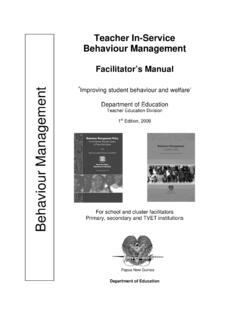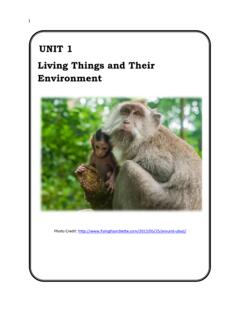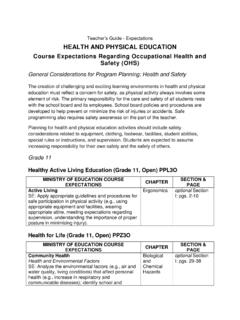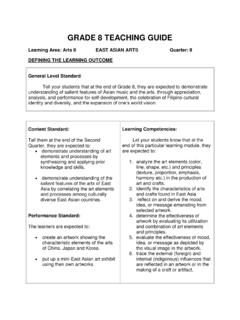Transcription of Information Communication and Computer Studies …
1 Information Communication Technologies and Computer Studies upper secondary teacher guide Papua New Guinea Department of Education Issued free to schools by the Department of Education Published in 2008 by the Department of Education, Papua New Guinea Copyright 2008, Department of Education, Papua New Guinea All rights reserved. No part of this publication may be reproduced, stored in a retrieval system or transmitted by any form or by any means electronic, mechanical, photocopying, recording or otherwise without the prior written permission of the publisher. ISBN 978-9980-9925-0-5 Acknowledgements The upper secondary Information Communication Technologies and Computer Studies teacher guide was written, edited and formatted by the Curriculum Development Division of the Department of Education.
2 The development of the teacher guide was coordinated by Gandhi Lavaki. Writers from schools, tertiary institutions and non-government organisations across the country have contributed to the writing of this teacher guide through specialist writing workshops and consultations. Quality assurance groups and the Information Communication Technologies and Computer Studies Subject Advisory Committee have also contributed to the development of this teacher guide . This document was developed with the support of the Australian Government through the Education Capacity Building Program. iii upper secondary teacher guide Contents Secretary s message .. iv The outcomes approach ..2 Learning and teaching ..5 ICT and Computer Studies requirements ..16 Assessing ICT and Computer Information Communication Technologies.
3 33 Sample assessment tasks ..34 Learning activities and assessment tasks ..39 Computer Studies ..53 Learning activities and assessment tasks ..54 Recording and reporting ..70 Resources ..74 References ..79 Glossary for ICT and Computer Glossary for assessment ..86 iv ICT and Computer Studies Secretary s message This teacher guide is to be used by teachers when implementing the upper secondary Information Communication Technologies and Computer Studies syllabuses (Grades 11 and 12) throughout Papua New Guinea. The Information Communication Technologies and Computer Studies syllabuses identify the learning outcomes and content of the subject as well as assessment requirements. The teacher guide gives practical ideas about ways of implementing the syllabuses: suggestions about what to teach, strategies for facilitating learning and teaching, how to assess and suggested assessment tasks.
4 A variety of suggested learning and teaching activities provides teachers with ideas to motivate students to learn, and make learning relevant, interesting and enjoyable. Teachers should relate learning in Information Communication Technologies and Computer Studies to real people, issues and the local environment. Teaching using meaningful contexts and making sure students participate in appropriate practical activities assists students to gain knowledge and understanding, and demonstrate skills in Information Communication Technologies and Computer Studies . Teachers are encouraged to integrate Information Communication Technologies and Computer Studies activities with other subjects, where appropriate, so that students can see the interrelationships between subjects and that the course they are studying provides a holistic education and a pathway for the future.
5 I commend and approve the Information Communication Technologies and Computer Studies teacher guide for use in all schools with Grades 11 and 12 students throughout Papua New Guinea. DR JOSEPH PAGELIO Secretary for Education 1 upper secondary teacher guide Introduction The purpose of this teacher guide is to help you to implement the Information Communication Technologies (ICT) and Computer Studies (CS) syllabuses. It is designed to stimulate you to create exciting and meaningful teaching programs and lessons by enabling you to choose relevant and purposeful activities and teaching activities. It will encourage you to research and look for new and challenging ways of facilitating students learning in Information Communication Technologies and Computer Studies . The teacher guide supports the syllabuses.
6 The syllabuses state the learning outcomes for the subject, outline the content and skills that students will learn, and provide suggested assessment tasks. The teacher guide provides direction for you in using the outcomes approach in your classroom. The outcomes approach requires you to consider assessment early in your planning. This is reflected in the teacher guide . This teacher guide provides examples of learning and teaching activities, and assessment activities and tasks. It also provides detailed Information on criterion-referenced assessment, and the resources needed to teach Information Communication Technologies and Computer Studies . The section on recording and reporting shows you how to record students marks and how to report against the learning outcomes. ICT and Computer Studies 2 The outcomes approach In Papua New Guinea, the Lower secondary and upper secondary syllabuses use an outcomes approach.
7 The major change in the curriculum is the shift to what students know and can do at the end of a learning period, rather than a focus on what the teacher intends to teach. An outcomes approach identifies the knowledge, skills, attitudes and values that all students should achieve or demonstrate at a particular grade in a particular subject (the learning outcomes). The teacher is responsible for identifying, selecting and using the most appropriate teaching methods and resources to achieve these learning outcomes. Imagine the student is on a learning journey, heading to a destination. The destination is the learning outcome that is described in the syllabus document. The learning experiences leading to the learning outcome are to be determined by the teacher . The teacher uses curriculum materials, such as syllabus documents and teacher guides, as well as textbooks or electronic media and assessment guidelines, to plan activities that will assist students achieve the learning outcomes.
8 The outcomes approach has two purposes. They are: to equip all students with knowledge, understandings, skills, attitudes and values needed for future success to implement programs and opportunities that maximise learning. Three assumptions of outcomes-based education are: all students can learn and succeed (but not on the same day or in the same way) success breeds further success schools can make a difference. The four principles of the Papua New Guinean outcomes approach are: 1 Clarity of focus through learning outcomes This means that everything teachers do must be clearly focused on what they want students to be able to do successfully. For this to happen, the learning outcomes should be clearly expressed. If students are expected to learn something, teachers must tell them what it is, and create appropriate opportunities for them to learn it and to demonstrate their learning.
9 2 High expectations of all students This means that teachers reject comparative forms of assessment and embrace criterion-referenced approaches. The principle of high expectations is about insisting that work be at a very high standard before it is accepted as completed, while giving students the time and support they need to reach this standard. At the same time, students begin to realise that they are capable of far more than before and this challenges them to aim even higher. 3 Expanded opportunities to learn This is based on the idea that not all students can learn the same thing in the same way in the same time. Some achieve the learning outcomes sooner and others later. However, most students can achieve high standards if they are given appropriate opportunities. Traditional ways of 3 upper secondary teacher guide organising schools do not make it easy for teachers to provide expanded opportunities for all students.
10 4 Planning and programming by designing down This means that the starting point for planning, programming and assessing must be the learning outcomes the desired end results. All decisions on inputs and outputs are then traced back from the learning outcomes. The achievement of the outcome is demonstrated by the skills, knowledge and attitudes gained by the student. The syllabuses and/or teacher guides describe some ways in which students can demonstrate the achievement of learning outcomes. Outcomes-based approach 1 What is it tha t s tudents need to know and be able to do? 4 What are the most appropriate strategies to use in teaching the content? 3 What are appropriate learning strategies and activities for assisting students to achieve the outcomes? 2 What is the best way to find out if the students have achieved the outcomes?


















